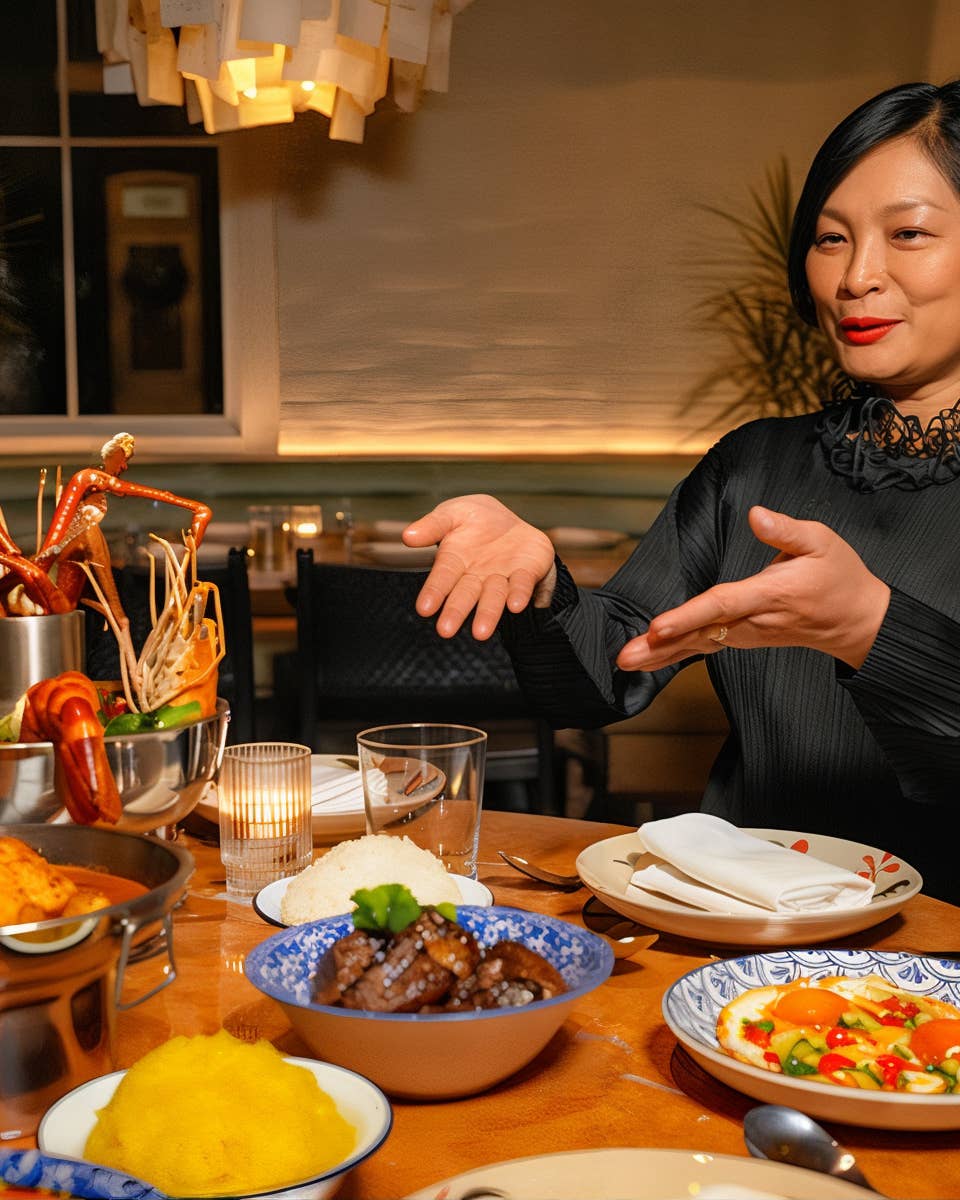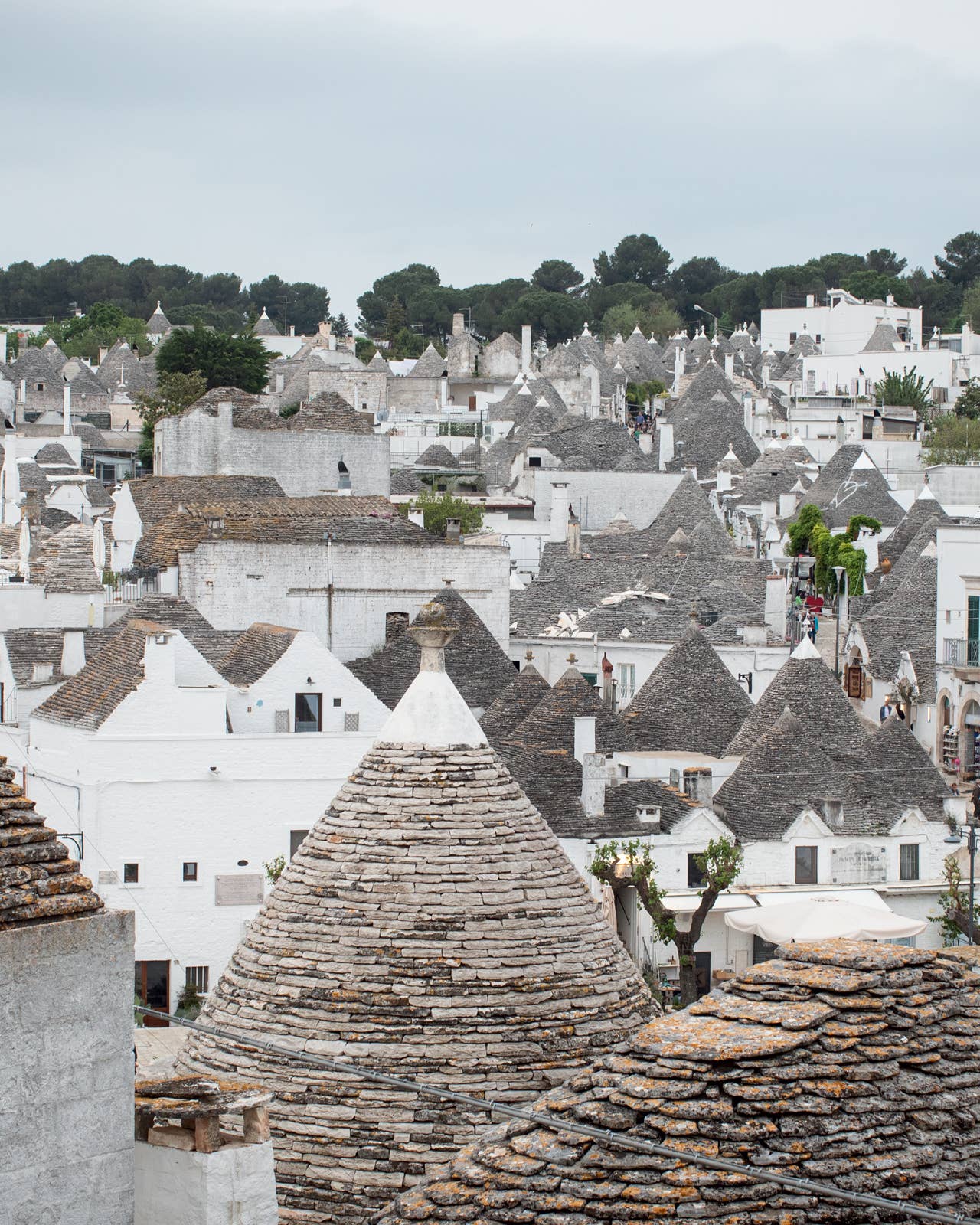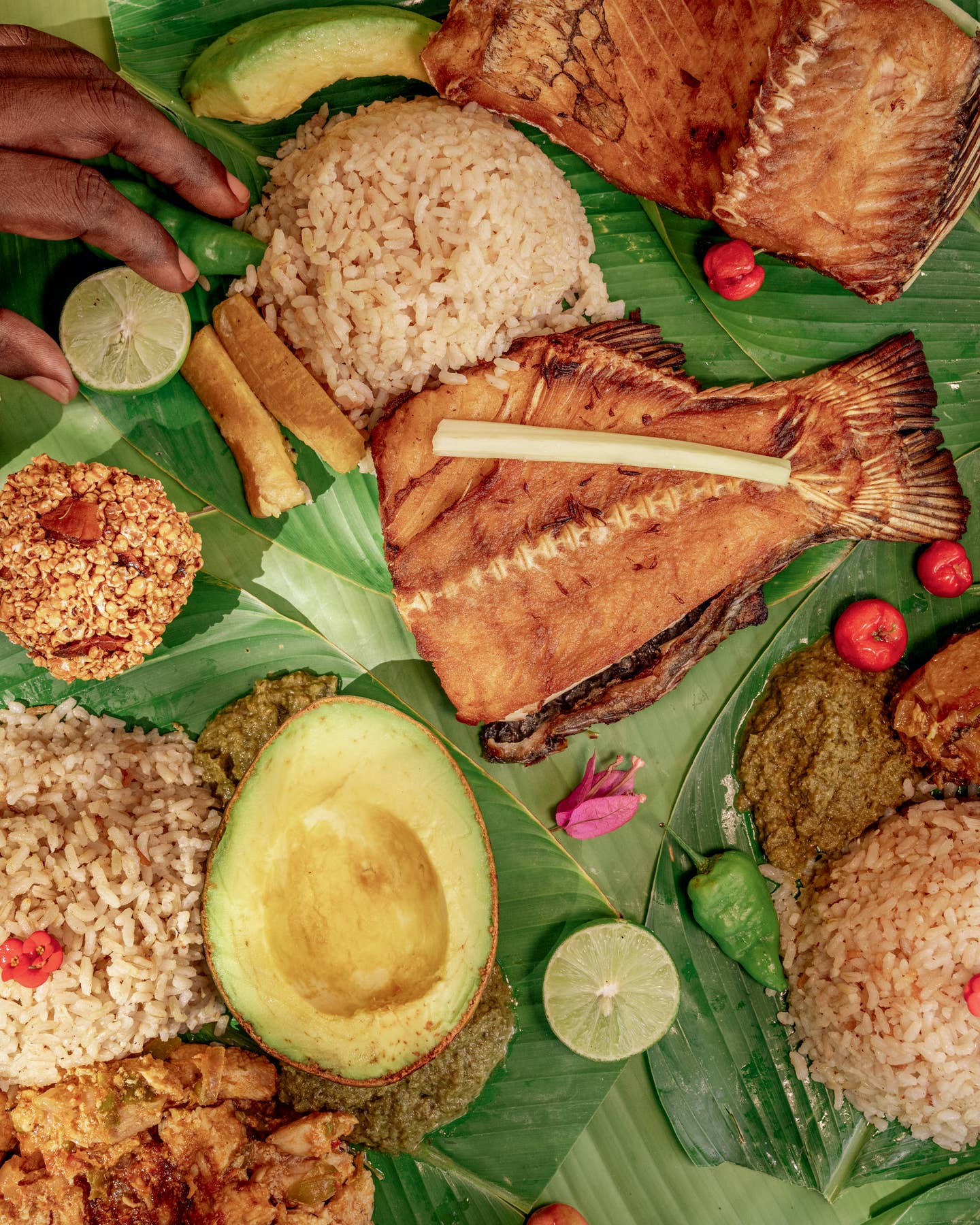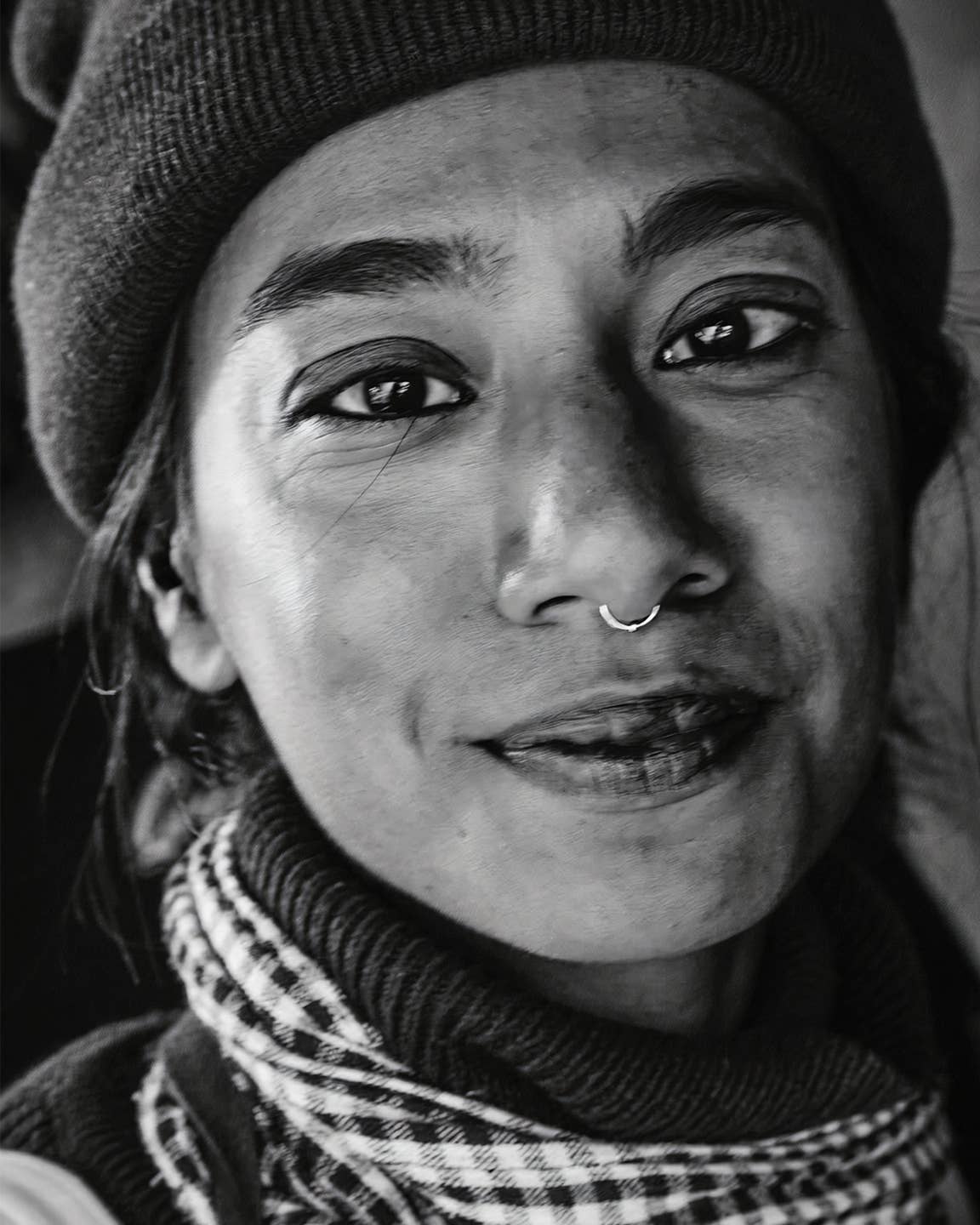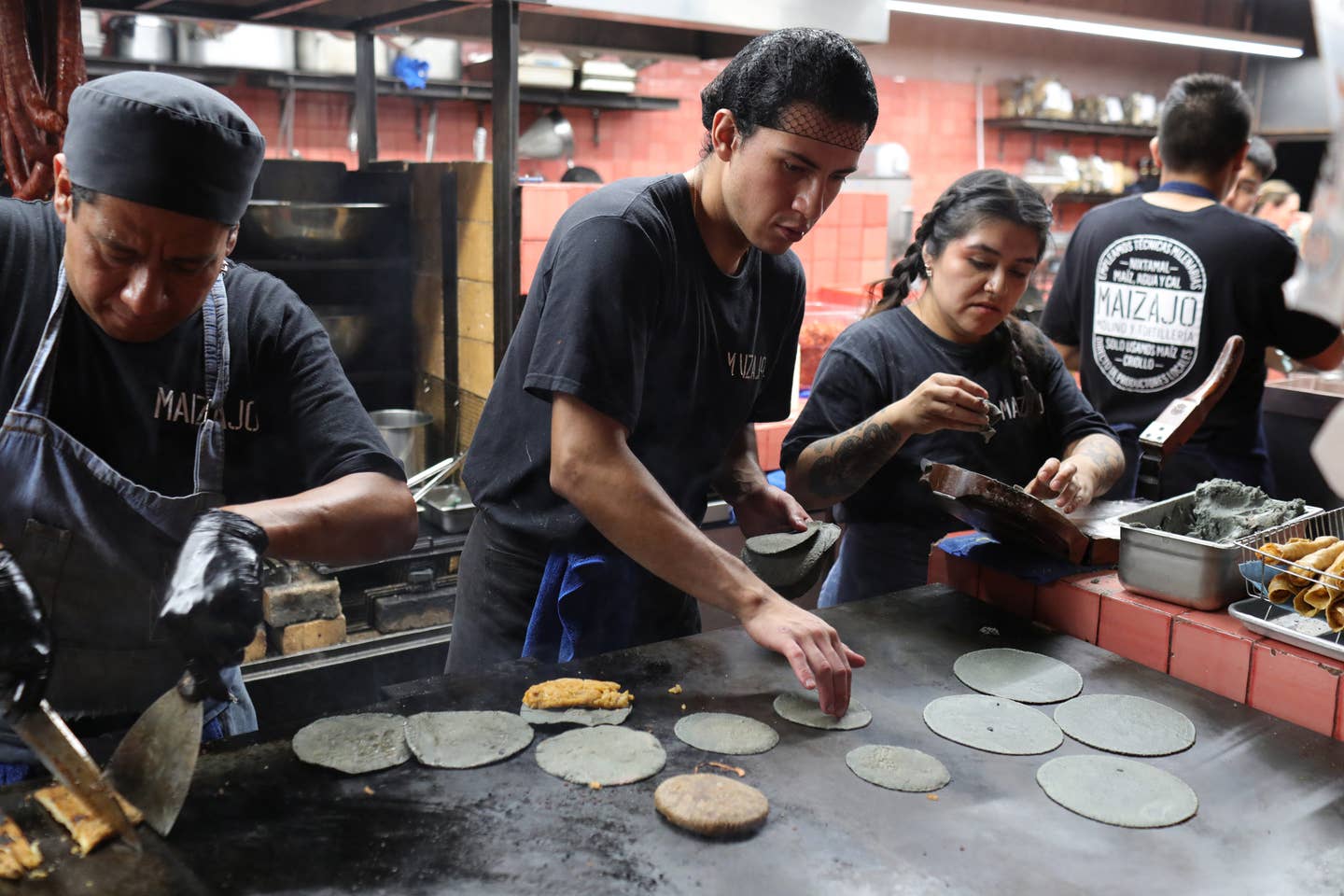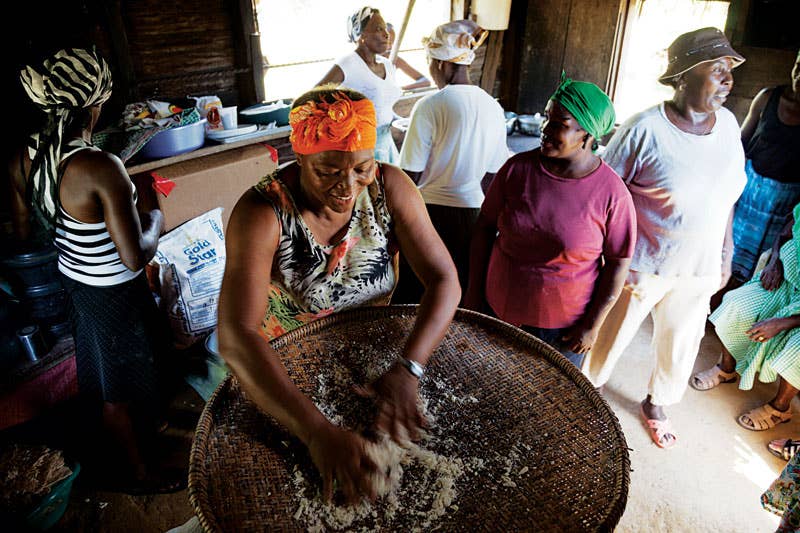
Cassava Nation
For the Garifuna people of coastal Honduras, coming together to cook the foods of their ancestors provides a sense of identity and continuity that transcends borders
The fish, rubbed with garlic and cumin, was frying, and the coconut milk was bubbling on the stove when Mama Nicha walked through the room. "Now it smells like a Garifuna kitchen!" she proclaimed in Spanish. At 75 years old, this tireless community leader presides over a busy household and language school in the seaside city of La Ceiba, Honduras. She was getting ready to teach a lesson to youngsters who were hoping to add English to the Spanish and Garifuna they already spoke.
Dionisia "Mama Nicha" Amaya-Bonilla and her students are Garifuna, descendants of Africans and Native Americans who live, a nation within nations, along the Caribbean coast of Honduras as well as in neighboring Belize, Guatemala, Nicaragua, and, nowadays, several U.S. cities. The most common story of their origins tells of slave ships that sank in the early-17th century, and of the Africans who escaped the wrecks and swam to the island of St. Vincent, there to mix with the indigenous Carib Indians and to thrive for more than 100 years, their numbers reinforced by other escapees of the region's slave plantations.
The Garifuna fished; they grew cassava and other Carib crops, as well as colonial imports like plantains, which they used in a dense mash akin to African fufu. They skirmished with the French and the British, resisting subjugation until 1797, when the British defeated them and exiled thousands of Garifuna to the island of Balliceaux. Starvation and illness decimated their numbers. Later that year, survivors were deported to the island of Roatan, off Honduras. From there they migrated to the mainland, eventually spreading out along Central America's Caribbean coast. The Garifuna brought their culture and language with them, living off the bounty of the shore. Though modern times have seen the Garifuna squeezed out of many of their valuable beachfronts, they remain fierce in their identity.
"We were deported from St. Vincent because we refused to be enslaved," Mama Nicha explained to me. "They deported us to nowhere, hoping we'd die. But we didn't. It's been 215 years, and we are still here."
In the kitchen beside Mama Nicha's classroom, her niece, Mirna Martinez, a big woman in a maroon dress and matching headwrap, was deftly cubing cassava and sweet potatoes in the palm of her hand with a dull kitchen knife. I knew the knife was dull because her cooking partner on this day, Robinson Chimilio, complained about it. A young chef in Coke-bottle glasses, Chimilio, like many Garifuna men, often works on cruise ships or abroad. He had arranged the mise-en-place just so for his dish—green banana dumplings called alabundigas, served with meaty turbot steaks in a coconut milk-based sauce. After a while, Martinez set out her tapou, a fish, green banana, and root vegetable stew emboldened with plenty of garlic and crimson achiote paste. We dug in, eating silently, scooping leftovers off of each other's plates, picking fish from the bone with our hands.
"Semeiti weigie, idia?" said my guide and friend, Lina Hortensia Martinez, and then she translated from Garifuna: Our food is delicious, right?
Indeed it was. I could understand why Chimilio and Mirna Martinez took such pride in their cooking. Elemental yet opulently flavored, these dishes said a lot about who the Garifuna are, and how, in a changing and challenging world, they manage to hold fast to their identity.
"Our food is survival food," said Mama Nicha after lunch. "We will not die of hunger if we have banana, fish, coconut, and we know that. You go to the sea and fish, and there are coconuts on the beach. You don't need money."
Of course, nothing, really, exists separately from money, not even the Garifuna culture. So I found the day I met Lina, a year before my trip to Honduras, at a food festival in the Bronx, where many of New York City's estimated 200,000 Garifuna live. Lina was in New York promoting her business of exporting cassava bread made by Garifuna women's cooperatives in the municipality of Iriona, in Honduras' remote northeast. For these women the starchy flatbread, a Garifuna staple, offers a potential livelihood and therefore a way to keep their coastal lifestyle—one based on communal fishing, farming, and cooking—intact.
I was so compelled by the down-to-earth beauty of the Garifuna foods I sampled that day that I called Lina afterward; without hesitation she invited me down to Honduras. And that's how I ended up here, among the Garifuna in and around La Ceiba, Lina's home, eating delectable Garifuna food. At Chef Guity, a restaurant overlooking La Ceiba's pier, we savored a creamy soup chock-full of tender hunks of conch, and another made with briny she-crabs bursting with roe. In the nearby Garifuna town of Corozal, we hung out beneath the pavilion roof of Restaurante Corozal, where proprietress Maritza Centeno maintains a museum of Garifuna folk objects, many of them cooking utensils. Of the enormous wooden mortar and pestle called a hana, used for pounding plantains, Centeno said, "This is African culture." There was a grater called an egi, fashioned from bits of jagged stone embedded in a board, and a ruguma, the woven sleeve used to squeeze the juice from grated cassava.
A group of young musicians from the local church slapped out Garifuna rhythms on their drums, and we devoured platters of fried conch, kingfish, plantains, and rice and beans. Though the lunch included foods eaten, as well, by the country's mestizo majority, the predominance of seafood reflected the Garifuna's coastal palate, and the rice and beans were sweet from cooking in that quintessential Garifuna ingredient, coconut milk.
Lina and I walked off lunch, strolling past concrete-block houses wedged between the highway and the Caribbean Sea. "When the road was built," Lina said, "people felt the land had been cut in half, so they moved to the beach side and sold the other. Now the Garifuna live shoved up next to one another, with health, water, and housing problems."
Among other challenges facing the Garifuna along this coastline, there are the land-grabbing tourist developments in Trujillo, two hours east of Corozal; the palm oil plantations threatening to swallow up Iriona; and the encroaching pan-American drug trade. Then there's lethal yellowing disease, which ravaged Honduras' coconut palms in the 1990s. For the Garifuna, who use coconut profusely—frying fish and plantains in its oil; making soups, stews, and breads with its milk; cooking its grated meat with ginger and unrefined sugar to make a fudge-like sweet called dabuledu—the loss was devastating. Though disease-resistant coconut palms have been introduced, "these are not the ones we're used to," Lina explained. "They have less oil."
Not that I would have known it from the wonderfully rich alabundigas and tapou and seafood soups I sampled. These Garifuna recipes are strong enough to have weathered the storm—despite the availability of fast foods and supermarket conveniences. "In the city, things have changed because of jobs and school. We have left that kind of cooking for the weekends, but we haven't lost it," said Lina's friend Teofila Valerio, a law student and gifted home cook, as she peeled plantains in the kitchen of her house in La Ceiba. "The lifestyle has changed, but the culture of the Garifuna will not change. The food will not change."
We had come to watch Teofila, who goes by Teo, make the most beloved of Garifuna dishes, hudutu. Prepared traditionally, many Garifuna dishes take a while and some effort to complete. But none match the labor intensiveness of hudutu. Both sweet, ripe plantains and unripe ones, which add a starchy consistency, must be boiled and then pounded—and pounded and pounded—to a smooth, dense paste. The paste is served alongside of, and as a utensil for, the fish and coconut stew that completes the dish. Often, Lina said, while the plantains are boiling, "men take a nap and expect to be awakened to do the mashing."
Since we had no men with us, the job was delegated to Lina. "When they hear the pestle hitting the mortar in the community," she told me, "people pass by your house and say, 'Oh, you're making hudutu!' That's a special sound." While Lina mashed, Teo prepared the stew. She started with coconut. If this were another dish—if she were making the Garifuna's sweet coco bread, for instance, which requires the richest milk—she might have stopped at what they call "first water," squeezing the grated fruit with only a small amount of water so as not to dilute its aromatic compounds. But for the stew she soaked and strained the grated coconut repeatedly to extract the milk. To that she added cumin, allspice, and a sofrito, or flavor base, of diced and sauteed aromatics—garlic, bell peppers, basil, culantro, and oregano, all pulled from her garden. Then, into the pot went thick kingfish steaks marinated in lime. Along with the pounded plantains, the finished stew made a hefty meal. I mopped up the last, luxurious drops with a sleek, sweet-savory hunk of the plantain mash and thought of the man I had met the day before in Corozal. "After I finish hudutu," he had told me, "I go to sleep."
The following morning, Lina, Teo, and I made the four-and-a-half-hour drive to the municipality of Iriona, traversing highways, forging rivers, and bumping along on country roads walled with coconut palms. Along the way, Lina serenaded us with Garifuna songs: "Meiguada la tia bere, meiguada la, meiguada la." May your strength not fall, may it not fall, may it not fall.
When we reached our destination in Iriona, the village of Ciriboya, women were gathered around a thatch-roofed hut that serves as a communal kitchen. "The Garifuna community does everything around feasting and food. If there's no food, they will highly complain," said Lina.
The occasion was the 40th birthday of Mirna Ruiz, a taut-muscled, lively woman who is a member of a cassava-producing cooperative that Lina works with. We found Ruiz and her friends at her sister's house, finishing up breakfast—coco bread and cups of porridge-like adulu, made with coconut milk and cassava flour, flavored with unrefined sugar and cinnamon—and assembling a few stews. As they cooked, the women bantered in both Spanish and Garifuna, a language derived from their Carib ancestors' but with plenty of African and adopted European words.
Like their language, their cuisine has borrowed from the dominant culture around them, while retaining its distinctly Garifuna character. I was handed a pot of ariran guisou, a spicy-sweet, mestizo-style chicken stew, and instructed to carry it down the road to the thatch-roof hut, where one of the women slid it into wood-fired handmade clay oven. Lina carried the darasa, green banana paste steamed in banana leaves harvested from the women's yards. "We call these traveling tamales," Lina said. "They can take away your hunger if you are walking a long distance."
The women here are used to journeys on foot; every week, they trek with their machetes to the steep hillside where they farm cassava. From the long, muddy path up to their high patch of land, the view of their pristine beach is breathtaking. It's easy to see why others would want to take it all from them. But as their men and children leave the village to find work elsewhere, the women have fought to hold on to this land, for cassava's sake. "Ereba nanibei weiyei," said Ruiz. Cassava bread is my husband. "Whenever I need some money, I know cassava bread will feed me."
While we celebrated, sitting at tables in the shade of a nance tree and feasting on guisou, rice and beans, darasa, and caramelly, dense banana and pumpkin breads, the women took turns working over a clay stove inside the thatched-roof hut. Using a hand broom fashioned from shrub branches, they spread cassava flour on a hot iron plate, patted it down with a wooden press, and when the starch had bound the disk-like bread together, they flipped it to toast the other side. Then they swiftly trimmed its edges with a machete, creating a big, bronzed, perfect circle.
"God made people in his image, and he made us Garifuna with our qualities," one proficient breadmaker told me. "When we dance and when we sing and when we eat, we show the world who we are, and we are content. We believe in our ancestors, and they have left us a lot of things: the cassava bread, all our foods."
She handed me a piece of the freshly cooked bread. It was nutty and chewy and smoky; it tasted wonderful. Then we all stood in a circle beneath the nance tree holding hands. Lina led us in prayer, asking God and the Garifuna ancestors for the wisdom and strength they would need to prosper as a community, and giving thanks for the gift of the meal we had all shared.
Keep Reading
Continue to Next Story




